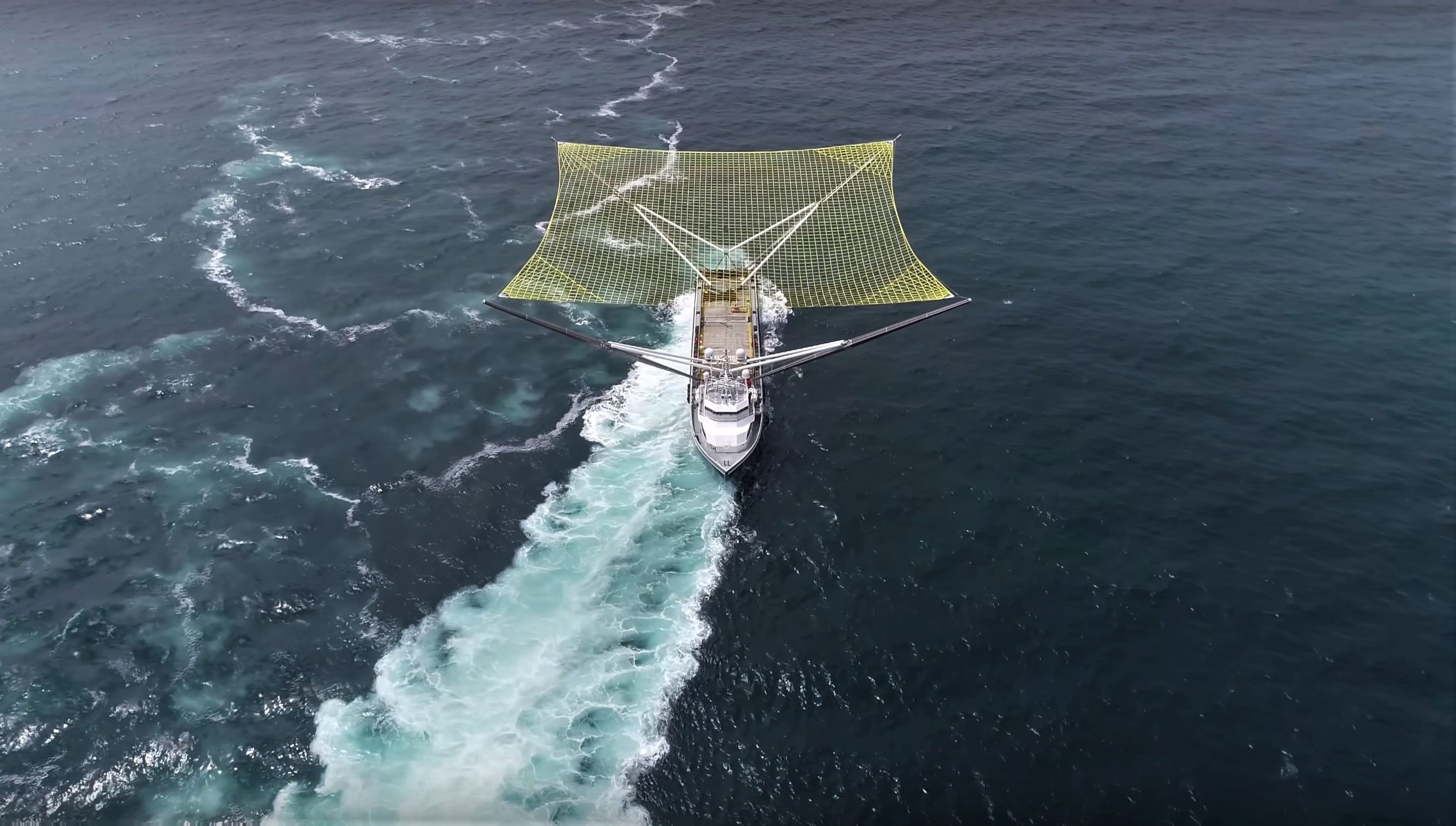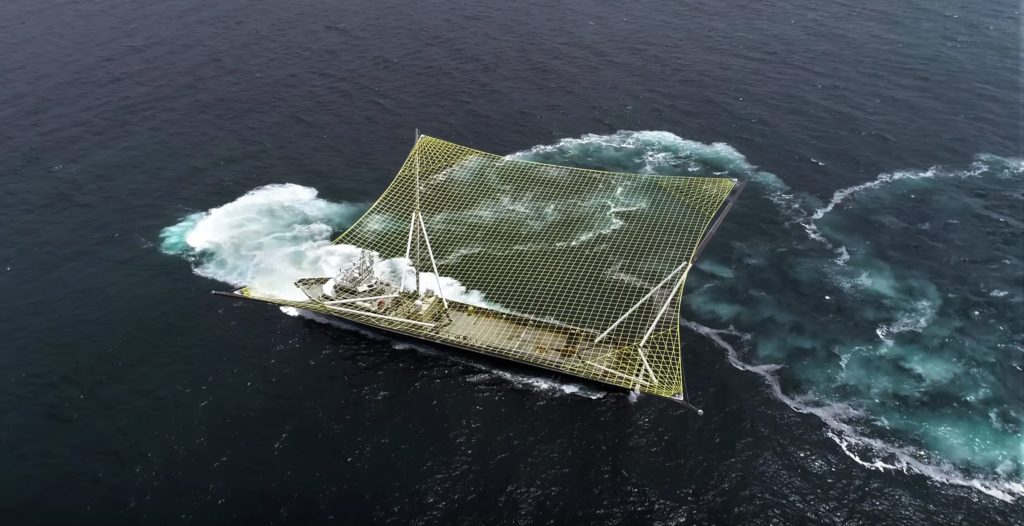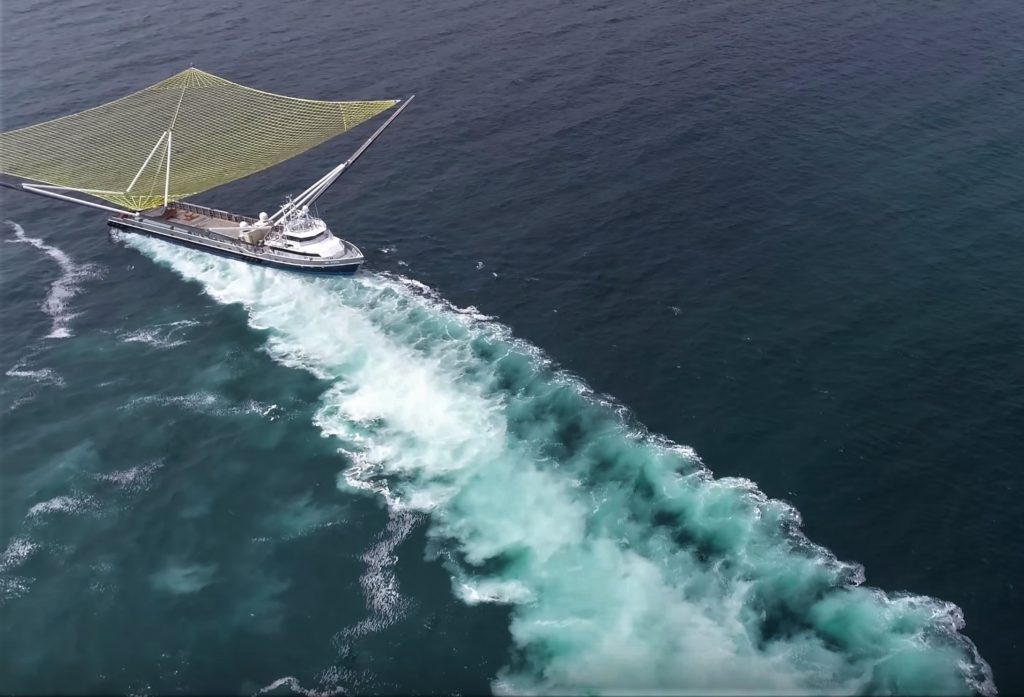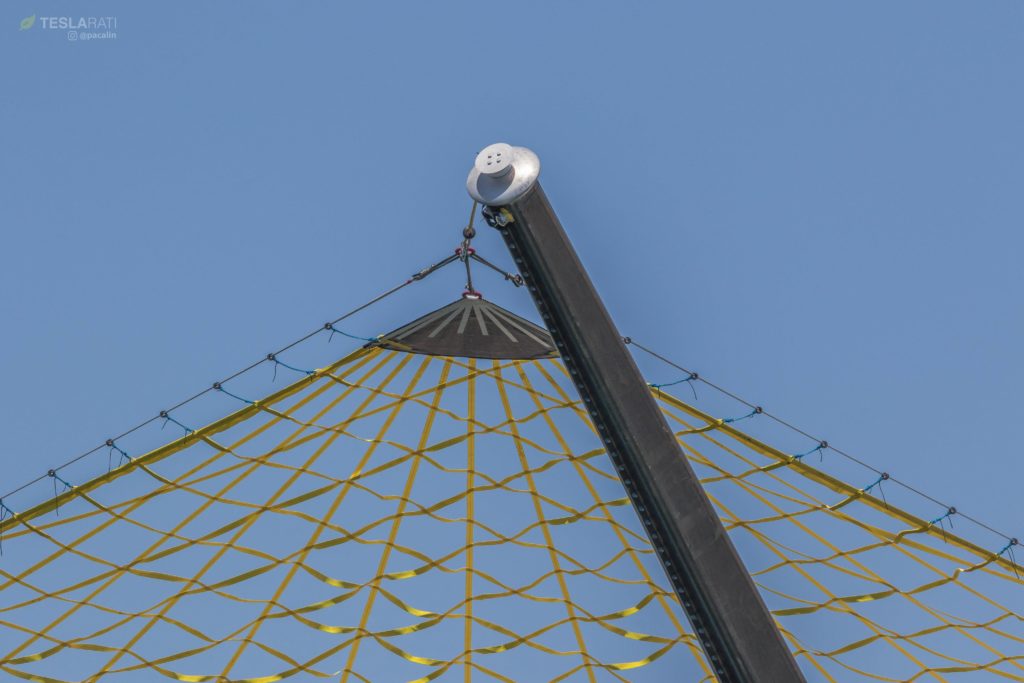

News
SpaceX’s Mr Steven spotted in high-speed test at sea with upgraded net
SpaceX’s newly-outfitted recovery vessel Mr Steven was recently captured conducting aggressive maneuvers off the coast of Port of Los Angeles, just days after the vessel’s massive new arms and net were installed for the first time. The intense pace of upgrades and acceptance testing confirm beyond any reasonable doubt that SpaceX does not intend to waste its next Falcon 9 fairing recovery attempt, set to accompany the July 25th launch of Iridium-7.
The iconic fairing recovery vessel has – for the past three or four weeks – been undergoing major upgrades to its arms or claws, as well as a massive, new net spanning nearly 0.9 acres (3700 m²). With what appears to be a genuine fourfold increase in usable area for fairing recoveries, SpaceX likely has a very strong chance of actually pulling off its first successful catches and reuses of Falcon 9 payload farings, valued at roughly 5% of the rocket’s cost ($3 million per a $60 million base price) per half. Manufacturing cost and price to the customer are difficult to compare, but it at least offers a hint of the full cost of each ~800 kg segment of carbon fiber and aluminum honeycomb.

Mr Steven seen just after a day spent conducting sea-trials a few miles offshore, July 14. (Pauline Acalin)
Based on photos and video captured between July 12 and 15, Mr Steven’s crew and recovery technicians appeared to waste no time at all leaping from arm and net installation to sea-trials of the new hardware at least as extreme as anything previously observed from the SpaceX-leased vessel. Less than half an hour after leaving the harbor for the first time since his massive new arms arrived, Marinetraffic tracking data showed that Mr Steven was already performing aggressive turns and sprints at speeds up to 20 knots (~25 mph), fairly impressive given the vessel’s 200 foot (62 meter) length and gross weight of nearly 200,000 pounds (82,000 kg).
While this may seem impressive, Mr Steven is a class of ship known as a Fast Supply Vessel (FSV) designed to routinely transport a full 400 metric tons of cargo on its deck at cruising speeds of 23 knots (27 mph), which means that the only thing Mr Steven’s wildly expansive arms likely challenge is the vessel’s center of gravity (balance), hence the follow-up tests with hard turns at high speed.
Also of interest, an extraordinary video of some of that testing – unofficially captured, somehow, by drone – showed the ship aggressively maneuvering in reverse, an ability that could come in useful during recovery attempts if the expanded net’s coincidental protection of Mr Steven’s cockpit means that it can become a less fixed element, actively seeking out falling fairings to help close the gap on each parasailing half’s 50 meter error margin.
- Mr Steven makes some serious waves, using his pod thrusters to strafe backwards at 5-10 knots. (anonymous)
- It’s subtle, but a small plus sign appears to ‘mark the spot’ on Mr Steven’s new net, stretching roughly 60×60 meters. (anonymous)
- Mr Steven shows off the fancy new rigging of that upgraded net. (Pauline Acalin)
Another opportunity fast approaches
Previously scheduled for July 20, Iridium’s NEXT 7 multi-satellite launch was pushed back a handful of days to July 25 to give SpaceX engineers and technicians additional time to prepare what is the company’s third Block 5 Falcon 9 to roll off its Hawthorne, CA assembly line. While suboptimal for the customer and for SpaceX’s manifest, that slight delay very likely padded slim schedule margins for Mr Steven’s major arm upgrades, meaning that the vessel will now be able to participate in the imminent launch’s recovery operations. After the first flightworthy vehicle’s debut in May 2018, SpaceX’s rocket production has ramped up in quite an extreme fashion, jumping from four first stages produced in six months to another three or four boosters completed and tested in Texas in just two months.
While the transportation of Falcon fairings and upper stages is far harder to keep track of, production of those critical components of the rocket have also reached throughput levels that are new territory for SpaceX, including an impressive statistic of an average of one full Merlin 1D rocket engine manufactured daily according to an individual with experience on the factory floor.
The Block 5 iteration of the workhorse SpaceX vehicle is in many ways a wholly new rocket, featuring an array of upgrades that include new heat shielding at the rocket’s base, interstage, and legs; retractable landing legs, upgraded Merlin 1D engines, and a clean-sweep refresh of the vehicle’s avionics, to name just a handful of the major changes included.

SpaceX technicians wrench on a trio of varied Merlin 1Ds in McGregor, Texas, where every single engine is test-fired before being attached to a Falcon 9. (SpaceX)
Follow us for live updates, peeks behind the scenes, and photos from Teslarati’s East and West Coast photographers.
Teslarati – Instagram – Twitter
Tom Cross – Twitter
Pauline Acalin – Twitter
Eric Ralph – Twitter
News
Tesla Robotaxi has already surpassed Waymo in this key metric
Tesla Robotaxi has already overtaken Waymo in Austin in one key metric, but there’s still more work to do.

Tesla Robotaxi has already surpassed Waymo in one extremely important key metric: size of service area.
Tesla just expanded its service area in Austin on Monday morning, pushing the boundaries of its Robotaxi fleet in an interesting fashion with new capabilities to the north. Yes, we know what it looks like:
🚨 Tesla’s new Robotaxi geofence is…
Finish the sentence 🥸 pic.twitter.com/3bjhMqsRm5
— TESLARATI (@Teslarati) July 14, 2025
The expansion doubled Tesla Robotaxi’s potential travel locations, which now include the University of Texas at Austin, a school with over 53,000 students.
The doubling of the service area by Tesla has already made its travel area larger than Waymo’s, which launched driverless rides in October 2024. It became available to the public in March 2025.
According to Grok, the AI agent on X, Tesla Robotaxi’s current service area spans 42 square miles, which is five square miles larger than Waymo’s service area of 37 square miles.
Tesla Robotaxi (red) vs. Waymo geofence in Austin.
Much can be said about the shape… but the Robotaxi area is now ~3.9 mi² (10 km²) larger than Waymo’s!! pic.twitter.com/dVfh2ODxJC
— Robin (@xdNiBoR) July 14, 2025
The service area is one of the most important metrics in determining how much progress a self-driving ride-hailing service is making. Safety is the priority of any company operating a ride-hailing network, especially ones that are making it a point to use autonomy to deploy it.
However, these companies are essentially racing for a larger piece of the city or cities they are in. Waymo has expanded to several different regions around the United States, including Arizona and Los Angeles.
Tesla is attempting to do the same in the coming months as it has already filed paperwork in both California and Arizona to deploy its Robotaxi fleet in states across the U.S.
As the platform continues to show more prowess and accuracy in its operation, Tesla will begin to expand to new areas, eventually aiming for a global rollout of its self-driving service.
News
Tesla Megapacks arrive for massive battery replacing coal plant
Tesla Megapacks have started arriving on-site to the Stanwell Battery Project, just as Queensland prepares to wind down the Stanwell coal plant.

The first of over 300 Tesla Megapacks have arrived to the site of a massive battery energy storage system (BESS) being built in Australia, dubbed the Stanwell Battery Project after a coal plant it’s set to replace.
In a press release last week, the Stanwell Battery Project announced that the first Tesla Megapack 2XL units had arrived to the site, which is located outside of Rockhampton in Queensland, Australia. The project will eventually feature 324 Megapack units, set to arrive in the coming months, in order to support the 300MW/1,200MWh battery project.
“The Stanwell Battery is part of the diversification of our portfolio, to include cleaner and more flexible energy solutions,” said Angie Zahra, Stanwell Central Generation General Manager. “It is just one part of the 800 MW of battery energy storage capacity we have in our pipeline.
“Capable of discharging 300 MW of energy for up to four hours (1,200 MWh), our mega battery will be one of the largest in Queensland.”

Credit: Stanwell
Did you know Tesla’s Lathrop facility churns out a Megapack every 68 minutes? That’s enough energy to power 3,600 homes for an hour per unit! ⚡️ pic.twitter.com/bG6fpHkB9O
— TESLARATI (@Teslarati) June 11, 2025
READ MORE ON TESLA MEGAPACKS: Tesla Lathrop Megafactory celebrates massive Megapack battery milestone
The state is working with government-owned company Yurika to facilitate construction, and the process is expected to create roughly 80 jobs. The project is expected to come fully online in May 2027, with initial commissioning of the Megapacks aiming for November 2025.
The Stanwell Battery is set to replace the nearby Stanwell coal generation plant, which the government is planning to wind down starting in 2026 as part of efforts to reach an 80 percent renewable energy generation ratio by 2035. Meanwhile, the government is also set to begin winding down the Tarong and Callide coal plants, while several other Megapack projects are being built or coming online. o ya
Tesla currently has two Megapack production facilities, located in Lathrop, California, in the U.S. and another that came online earlier this year in Shanghai, China. The Shanghai Megafactory shipped its first units to Australia in March, while both factories are expected to be capable of producing 10,000 Megapack units per year upon reaching volume production.
News
The Tesla Diner is basically finished—here’s what it looks like
The company first broke ground on the Diner, Drive-in, and Supercharger location in September 2023. Now, it has served one of its first internal customers.

Tesla has finally completed the construction of its highly anticipated Diner, Drive-in, and Supercharger in Los Angeles, and recent photos of the interior’s “retro-futuristic” style are making their way around the internet.
X user Brad Goldberg shared photos from the Tesla Diner site last Tuesday, depicting some of the Supercharger stalls, indoor and outdoor seating areas, multiple neon lights, and even an Optimus robot. Goldberg also noted that there had been a “flurry of activity on site” while he was snapping the photos last week, suggesting that the restaurant location could be getting close to opening.
The Tesla Diner also served one of its first internal customers in the past few days, as Elon Musk posted on X on early Monday morning that he had just finished up eating a meal at the site:
I just had dinner at the retro-futuristic Tesla diner and Supercharger.
Team did great work making it one of the coolest spots in LA!
The photos also show that the site is pretty much done, with some of them even showing vehicles charging at the charging stalls.
You can see some of the latest photos of the Tesla Diner below.

Credit: BradGoldbergMD | X

Credit: BradGoldbergMD | X

Credit: BradGoldbergMD | X

Credit: BradGoldbergMD | X

Credit: TeslaKing420 | X

Credit: TeslaKing420 | X

Credit: Brad Goldberg (via Sawyer Merritt on X)

Credit: Brad Goldberg (via Sawyer Merritt on X)

Credit: Brad Goldberg (via Sawyer Merritt on X)

Credit: Brad Goldberg (via Sawyer Merritt on X)

Credit: Brad Goldberg (via Sawyer Merritt on X)
READ MORE ON TESLA’S LA DINER: Tesla readies Drive-In Diner Supercharger for launch with app inclusion
When will the Tesla Diner open to external customers?
While it’s still not open to external customers yet, the news again suggests that the company could be close to an official opening date. Tesla first broke ground on the Diner in September 2023, after receiving a wave of building permit approvals throughout that year. Teslarati also covered much of the construction progress throughout last year, including when crews installed the first and second drive-in screens.
Located at 7001 West Santa Monica Boulevard, the idea was first discussed in 2018 by Musk and a few others on Twitter, featuring 1950s rock and roll, waiters on roller skates, and drive-in movie theater screens playing clips from some of history’s best movies. Notably, the photos of the front doors also show that the site will be open 24 hours a day, 7 days a week, whenever it does end up opening.
Tesla’s progress on Supercharger with diner, drive-in seen in aerial footage
-

 Elon Musk2 weeks ago
Elon Musk2 weeks agoTesla investors will be shocked by Jim Cramer’s latest assessment
-

 News2 days ago
News2 days agoTesla debuts hands-free Grok AI with update 2025.26: What you need to know
-

 Elon Musk4 days ago
Elon Musk4 days agoxAI launches Grok 4 with new $300/month SuperGrok Heavy subscription
-

 Elon Musk6 days ago
Elon Musk6 days agoElon Musk confirms Grok 4 launch on July 9 with livestream event
-

 News1 week ago
News1 week agoTesla Model 3 ranks as the safest new car in Europe for 2025, per Euro NCAP tests
-

 Elon Musk2 weeks ago
Elon Musk2 weeks agoxAI’s Memphis data center receives air permit despite community criticism
-

 News4 days ago
News4 days agoTesla begins Robotaxi certification push in Arizona: report
-

 Elon Musk2 weeks ago
Elon Musk2 weeks agoTesla scrambles after Musk sidekick exit, CEO takes over sales






















